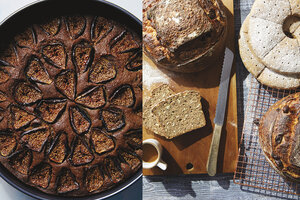More quality time spent in the kitchen? Yes, please.
Nigella Lawson’s “Cook, Eat, Repeat” and Roxana Jullapat’s “Mother Grains” offer practical ideas and inspiration for taking cooking to new heights.

Figgy and Purple Barley Cake (left) and assorted breads made with rye from the cookbook "Mother Grains" by Roxana Jullapat.
Kristin Teig/W. W. Norton & Company
What do avocado toast and kitten heels have in common? They both reflect trends: one in food, one in fashion. Two new appealing spring cookbooks, Nigella Lawson’s “Cook, Eat, Repeat” and Roxana Jullapat’s “Mother Grains,” reflect the times we’re in right now – as do Zoom calls and Etsy masks.
During the long months of sheltering in place, baking emerged as an absorbing distraction, filling homes with delicious comfort.
Los Angeles baker Jullapat’s “Mother Grains” provides plenty of reasons to continue doing just that. It’s a welcome primer on the increasingly popular, ancient, heirloom, and artisan whole grains that might have filled the hole when all-purpose flour was hard to find, and will help us now add interest and nutritious variety to our baking.
I have long rated cookbooks by what I call their IQ – short for irresistibility quotient – based on the number of recipes I can’t wait to try. “Mother Grains” is at the Mensa level, right up there with Maida Heatter’s and Yotam Ottolenghi’s books.
Jullapat highlights eight grains: barley, buckwheat, corn, oats, rice, rye, sorghum, and wheat. All can be considered ancient – that is, unaltered by domestication – and all are grown domestically and available nationwide; though, without resorting to mail order, I have yet to find the Sonora flour or blue cornmeal called for in several recipes.
Jullapat’s multiple versions of chocolate chip cookies are a good place to start – and worth the price of the book. An enticing two-page photo spread of what might arguably be America’s greatest gift to baking (sorry, apple pie lovers) graphically shows the different depth of color depending on the grain used.
Her basic version, made with half sorghum flour and half all-purpose, came out perfectly: flat, crisp on the edges, chewy in the middle, and beautifully golden. But I preferred the slightly less sweet all-rye version, also gorgeous, which she sells at her Friends & Family bakery in Los Angeles.
My only complaint is that Jullapat’s 16-cookie yield is not enough. I doubled all recipes, and froze balls of dough to bake fresh as needed.
This was my first time baking with sorghum, which is also featured in what she calls Trouble Cookies – not that they are any trouble to make, but because they’re an irresistible mix of dark brown sugar, cashews, shredded coconut, and English toffee bits.
I’ve cooked with buckwheat before, though my previous attempts at buckwheat pancakes and crepes tasted like papier-mâché. Jullapat’s baked buckwheat pancake was actually pillowy.
There are savory recipes, too. A shiitake, leek, and toasted barley soup solved the problem of mushy barley. There’s a whole-grain pizza dough, several oatmeal recipes, bagels, and, of course, Danish rye bread. A freekeh dish with shiitake mushrooms, leeks, and sugar snap peas is on my to-cook list, though ginger scones are likely to take precedence.
Lawson, known for big celebratory layer cakes and roasts in books like “Feast” and “Nigella Christmas,” offers homey, adaptable ideas in “Cook, Eat, Repeat.” The title of her 12th book, which features easygoing recipes she prepares regularly, nails the way many might summarize this past year’s relentless cycle of home cooking. It’s a chatty, meandering “culinary stream of consciousness” punctuated by recipes, geared as much to armchair reading as to goal-directed kitchen forays.
Lawson acknowledges that during lockdown, procuring ingredients could be a challenge. “No one has the stifling luxury of inflexibility,” she writes. Nor are we hosting parties. Many of her suggestions are for solitary eaters, including a fried chicken sandwich, which “Serves 1, ecstatically.” A chapter meant to be called “How to Invite People for Supper Without Hating Them (or Yourself)” became “Much Depends on Dinner.” Cooking, she argues, can be drudgery, “but it is also a way to make a substantive difference to the emotional temperature of the days,” offering “both immersion and escape” – and a modicum of control.
Lawson makes a case for some of her favorite ingredients, including anchovies, rhubarb, celery root, and “brown food,” which encompasses meat stews. Anchovies, the flavor bombs that have been called the “bacon of the sea,” turn up in dips and canapés, and are combined with celery root in a creamy gratin.
Rhubarb gets put to use in that quintessentially British dessert, trifle, as well as a beet, rhubarb, and ginger soup, which my tasters either loved or loathed. It will not be entering my repertoire.
Lawson has a fondness for comforting, “squidgy” nursery foods, which leads to plenty of mashes, peas, puddings, pastas, and plain loaf cakes. There’s even a rice pudding cake and a dish made with frozen, breaded fish sticks. She also offers vegetarian and gluten-free adaptations for many recipes.
One amusing twist with potential child appeal features roast chicken served on a bed of potato chips right from the bag. Here’s how she sells it: “The chips under the chicken pieces become gooily sticky and sodden with savory juices; the potato chips around the edge remain crisp and crunchy.”
Fun. Which is what both of these cookbooks succeed in doing: sparking joy in the kitchen, even after a year of seemingly endless home cooking.

